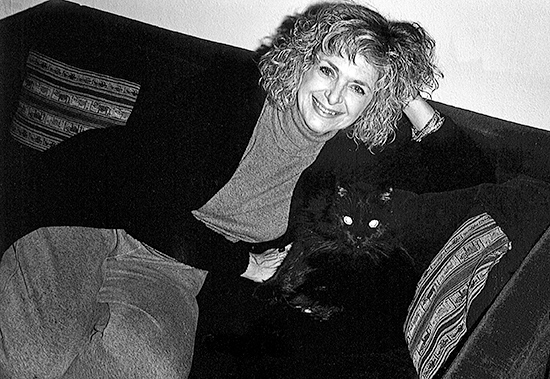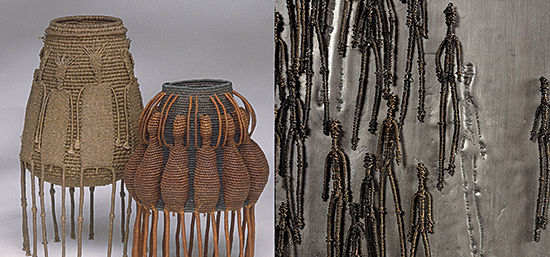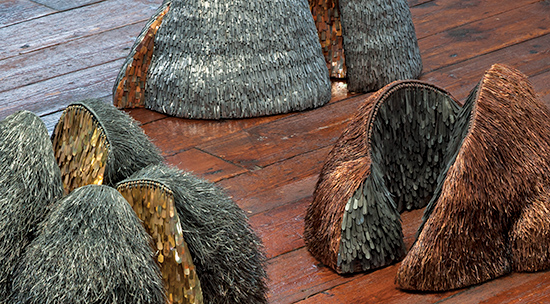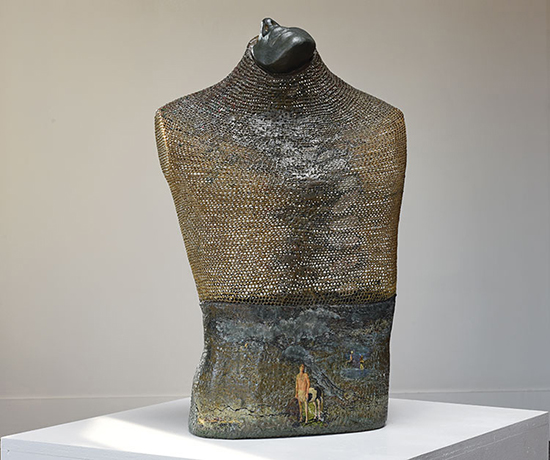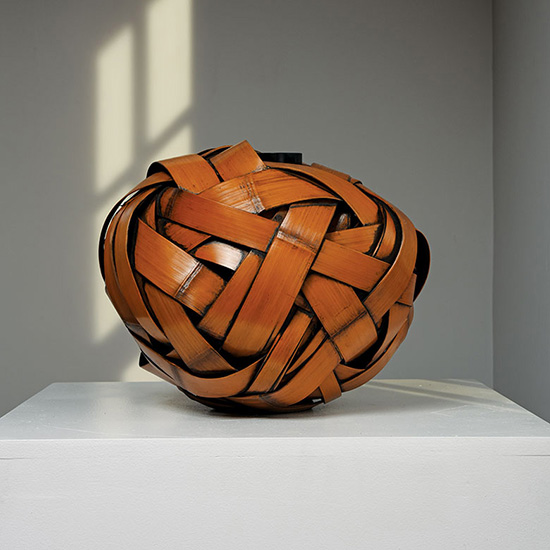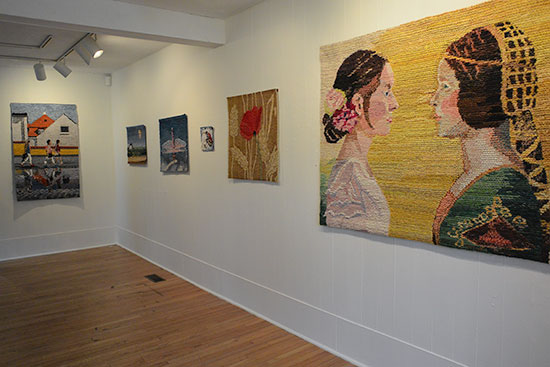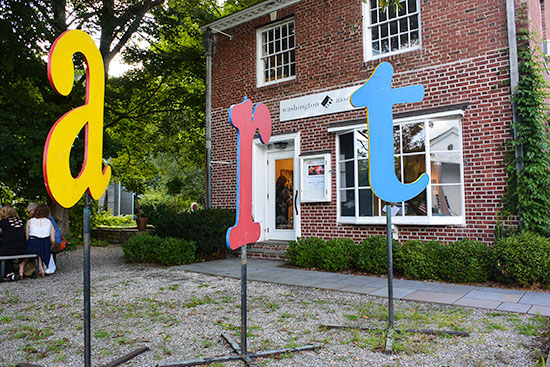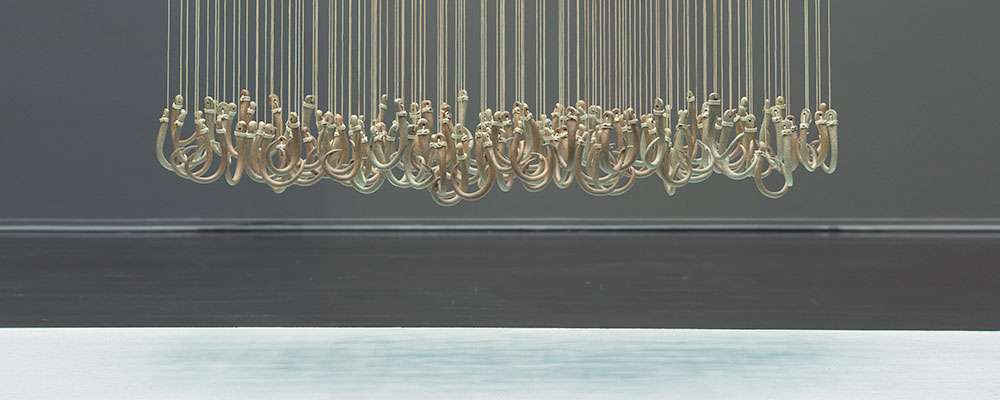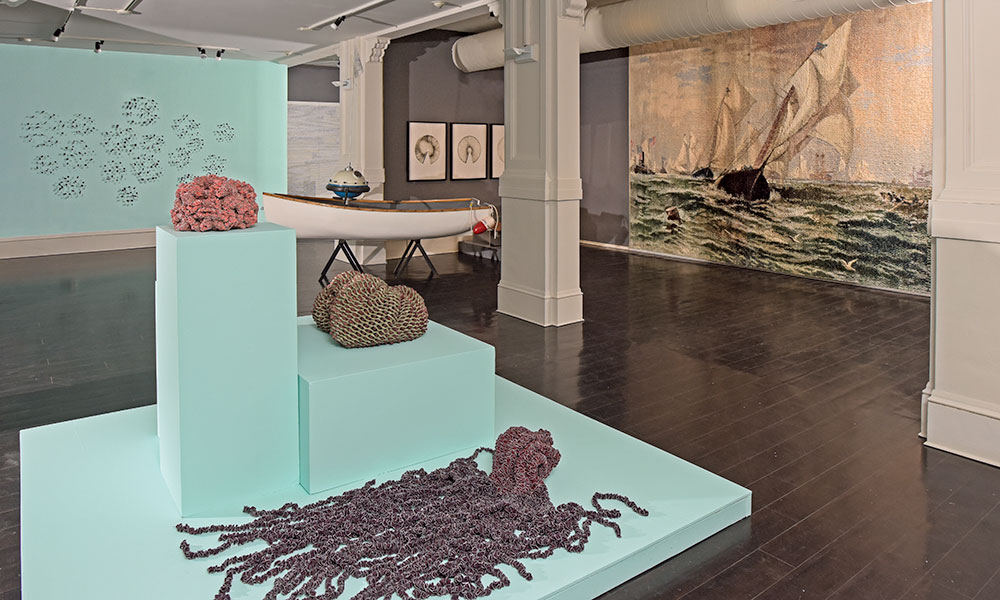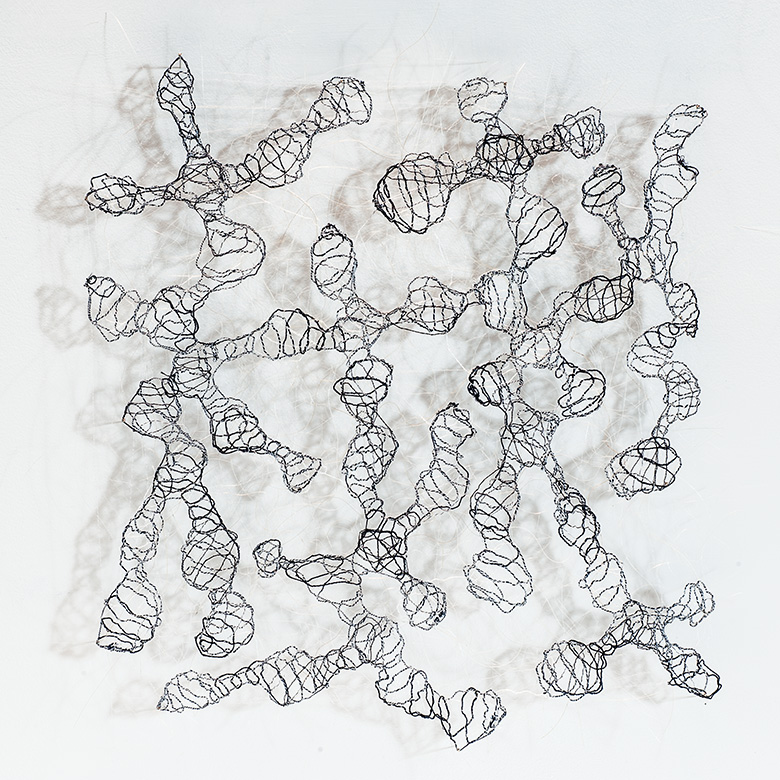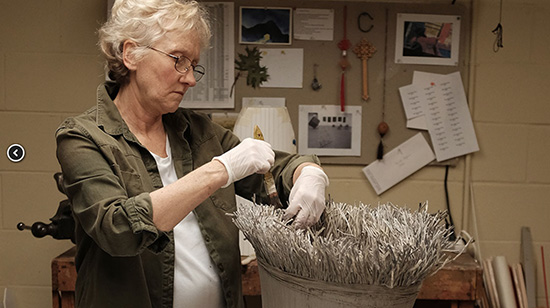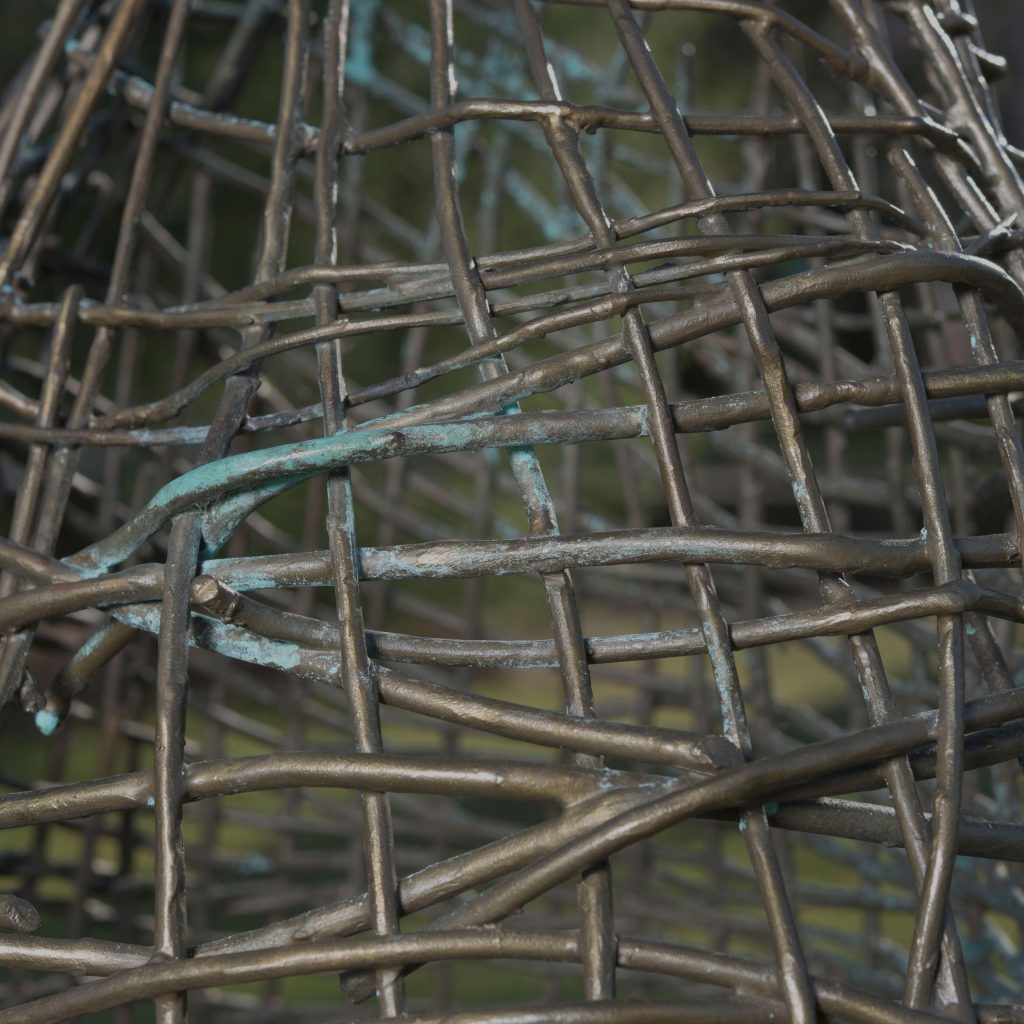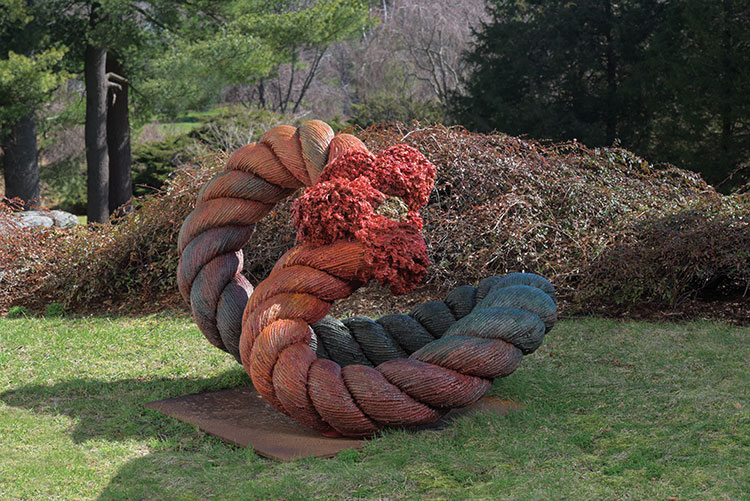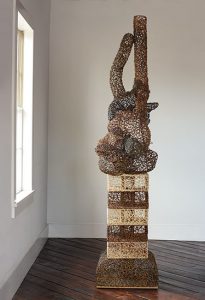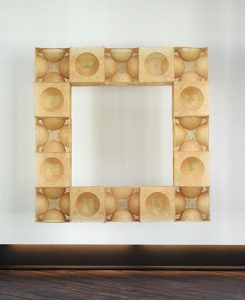We were heartbroken to learn of artist Mary Giles’s passing last month. Giles was a light – casting warmth and humor wherever she went. We have been fortunate to represent her work at browngrotta arts for many years and were delighted she could join us in Wilton for our 30th anniversary exhibition last year.
Art Lives Well-Lived: Mary Giles
Happy New Year: to new beginnings, fresh starts, rewrites and resurrections
Mariyo Yagi’s works, including A Cycle, Infinity, resonate with her nawa principle: spiral energy of movement and human beings together creating a metaphorical rope, all pulling together. What better sentiment for the New Year? We at browngrotta arts wish you all an awesome and abundant year. https://www.youtube.com/watch?v=cDSqnF_Wjac
Art Assembled: Art Featured in August
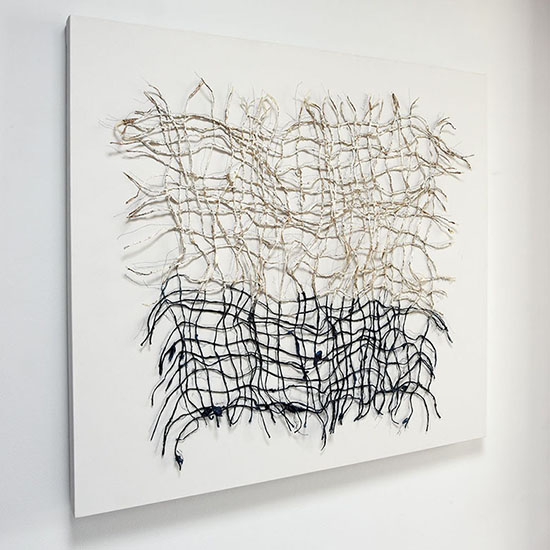
Southern Crossing Six by Kiyomi Iwata, Kibiso, silver leaf, indigo-color dye on canvas with pencil drawing, 30” x 33” x 1.75”, 2015
We started off August with Norma Minkowtiz’s Twister, a figure shaped sculpture made from fiber, paint, and resin. In works such as Twister Minkowitz explores her thoughts on the different paths people take in life. “Some of my themes explore making concessions, personal choices, different lifestyles, ways of survival and transitions in nature as well as human nature. I am engaged in creating works that weave the personal and universal together,” explains Minkowitz.
Next up we had Southern Crossing Six by Kiyomi Iwata. Iwata began her new series Southern Crossing Six after he recent move from New York to Richmond, Virginia. The move to the South felt as dramatic as her move from Japan to the United States many decades ago. While Iwata’s move from Japan to the United States was characterized by youthful anticipation and excitement, her move from New York to Richmond was much different. Iwata’s need for adventure was replaced by a desire of comfort of the familiar. The stark contrast between indigo dyed Kibiso silk and silver leaf juxtapose the two different landscapes…
Fossil, a bamboo sculpture by artist Jiro Yonezwa is a true masterpiece. Yonezawa, who studied in Beppu and apprenticed under Masakazu Ono, has been a bamboo basket maker and artists for over 35 years. For Yonezwa, it is the regenerative nature of bamboo which attracts him to the art form. While living in the United States from 1989 to 2007 his artwork became larger, bolder, and more sculptural. Yonezawa finds the process of preparing bamboo strips to weave, and the weaving the strips to be inherently meditative. While going through this process “the cacophony of life dissipates; the sculpture emerges vigorous and vibrant. Form, contrast, balance, and the interplay of space, color and texture” all come together.
Made with thousands of strands of 18-carat gold threads and Japanese silk thread, Grethe Wittrock’s Gold Reserves has a tactile sculptural presence. Like Wittrock’s Nordic Currents series, Gold Reserves also celebrates Danish Design and craftwork traditions. Unknown to many, the Danish national gold reserves were shipped to New York right before the start WWII to be stored in vaults at the Federal Reserve Bank to be kept safe from the Nazis.
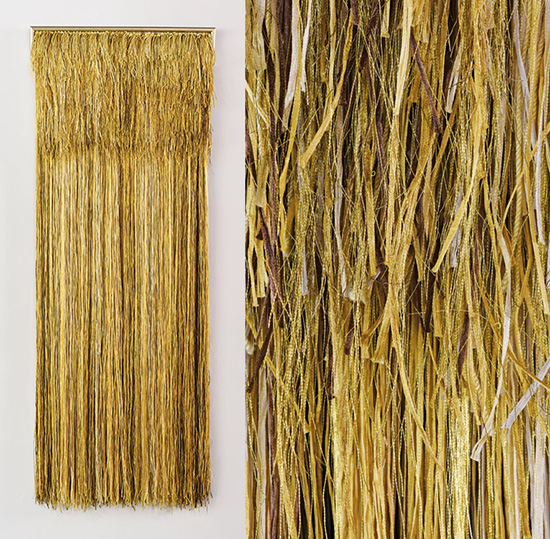
Gold Reserves by Grethe Wittrock, custom-dyed Japanese silk yarns, konjaku root starched, various gold yarns, cotton yarn, 63” x 24”, 2008/09
“Although she attempts to retain a sense of the material in its raw state, she pushes it sculptural possibilities,” explains Milena Hoegsberg. Wittrock aims “to ‘respect’ the raw materials ‘energy’ by distilling it ‘to reveal its essence’.” Wittrock tediously chose the color combinations for each group of threads that were to be knotted, taking into consideration where the groups would lay against the brown threads and the texture they would create.
The Nordic Tapestry Opens in Washington Depot, CT
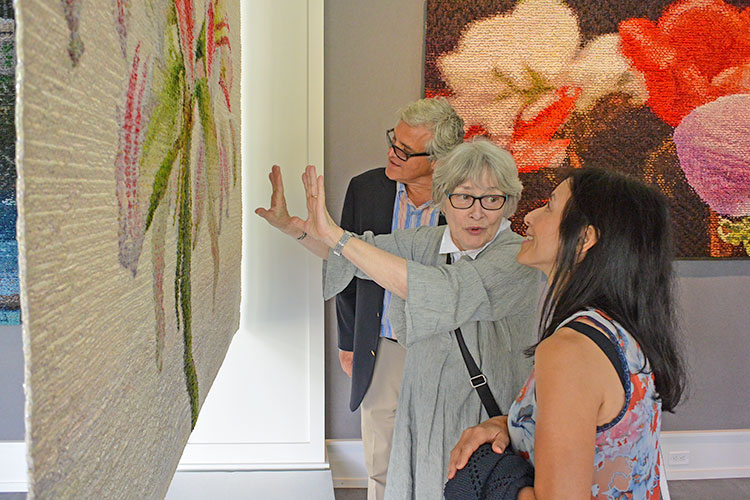
Helena Hernmarck talking about her work at the opening reception of The Nordic Tapestry Group: Weaving Knowledge into Personal Expression, photo by Tom Grotta
The Nordic Tapestry Group: Weaving Knowledge into Personal Expression opened on Saturday in Washington Depot, Connecticut at the Washington Art Association and Gallery, 4 Bryan Plaza and the Judy Black Memorial Park and Gardens at One Green Hill. The exhibition extends through September 9th. The Nordic Tapestry group was founded 10 years ago by weavers from Sweden, Iceland and the United States after tapestry artist Helena Hernmarck traveled to Sweden to teach workshops on her weaving technique. Combining traditional Swedish weaving techniques with her own method, Hernmarck is able to achieve powerful photorealistic effects by bundling a variety of hued yarns that combine to create an illusion of depth. With a common passion for textiles, members of the Nordic Tapestry group have a desire to learn more about how Hernmarck’s tapestries are made, how to use light and how to use the different qualities of yarn to create images. The exhibition highlights works by 21 of those students alongside Hernmarck’s works. Hernmarck’s Anemones (1985) dominates one of the exhibition galleries, attractively paired with the more recent and more translucent work, Amaryllis (2014). Holding their own in the large gallery are also Stone Bridge and the impressionistic Morning Haze, by Lis Korsgen, Hernmark’s very accomplished student.
In the Washington Art Association building are other works from Face to Face, which reveals the Nordic Tapestry weavers shared passion and ongoing exchange, and celebrates the transfer and evolution of weaving knowledge into personal expression. Through these works, they display their interest in using light and color and exploring the different qualities of yarn to weave images, create space and depth, and to depict three-dimensional forms. Swedish weaving has had a influential history in this country, in exhibitions, in creating art for the United Nations and in the curriculum at Cranbrook. For a very comprehensive look at this influence, including the role Swedish weaving has played in the work of American weaver Lia Cook, read Marion T. Marzolf’s paper, for the Textile Society of America, The Swedish Presence in 20th-Century American Weaving, http://digitalcommons.unl.edu/cgi/viewcontent.cgi?article=1313&context=tsaconf.
Art Assembled Featured in May
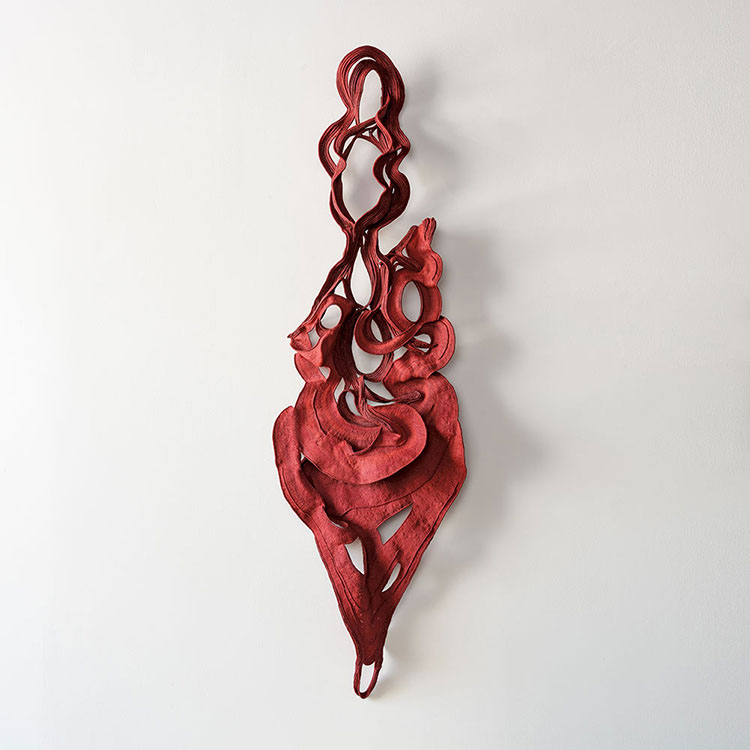
3fj Interior Passages, Ferne Jacobs, coiled and twined waxed linen thread, 54” x 16” x 4”, 2017, Photo by Tom Grotta
Tapestry and sculptural fiber were on tap in May as browngrotta arts’ New This Week selections. First up, Interior Passages, Ferne Jacob’s remarkable wall sculpture of coiled and twined wax linen, a large and complex work that speaks against the desecration of women around the world. Interior Passages needs no one to tell her who she is or what she is says the artist. “She knows her value, and I expect the world to respect this inner understanding. When it doesn’t, I think it moves toward a destructiveness that can be devastating.”
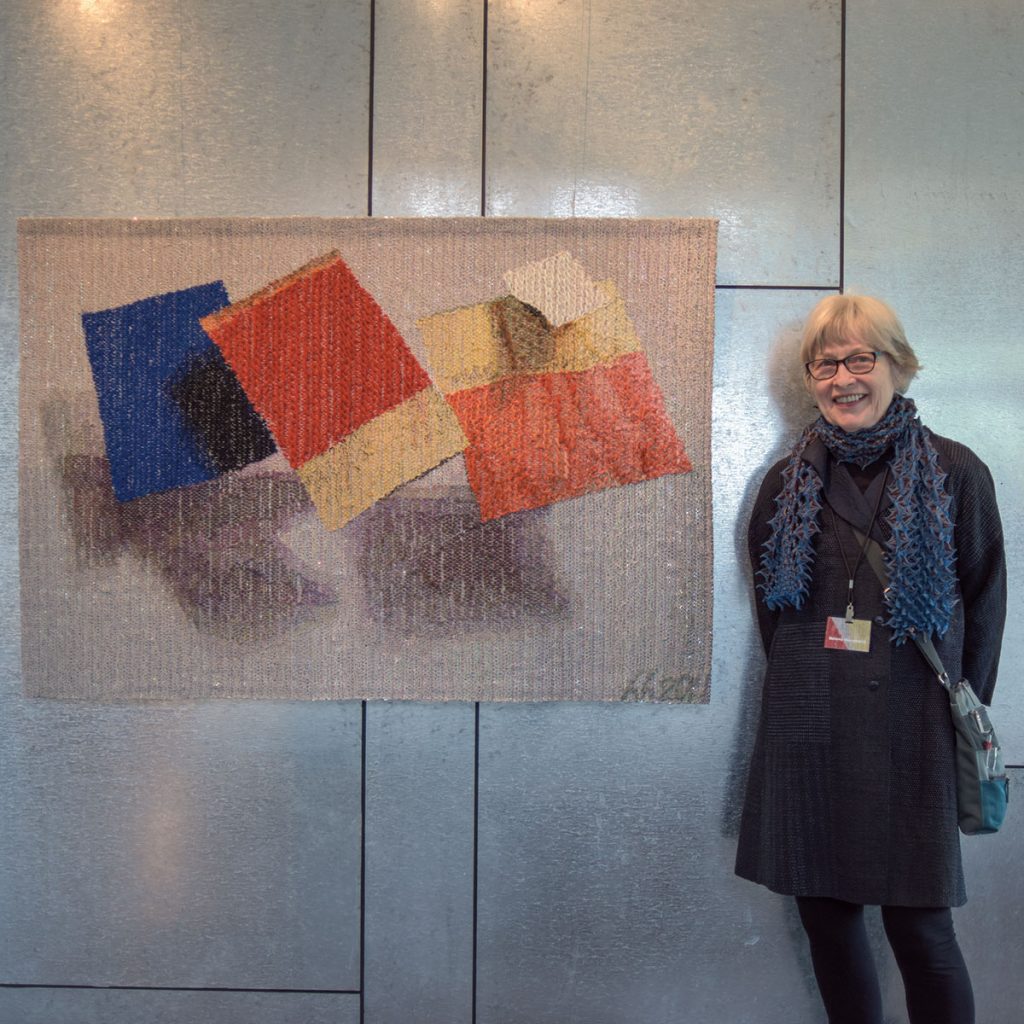
Helena Hernmarck in front of her tapestry Tabula Rasa 3, 2011, Wool, 37.5″ × 57″, Photo by Carter Grotta
Helena Hernmark’s Tabula Rasa 3 , integrates an unusual background of polyester from sequin making that adds a glimmer to the tapestry in the right light. The work is part of a series that included the first Tabula Rasa, commissioned for Yue-Kong Pao Hall, Purdue University.
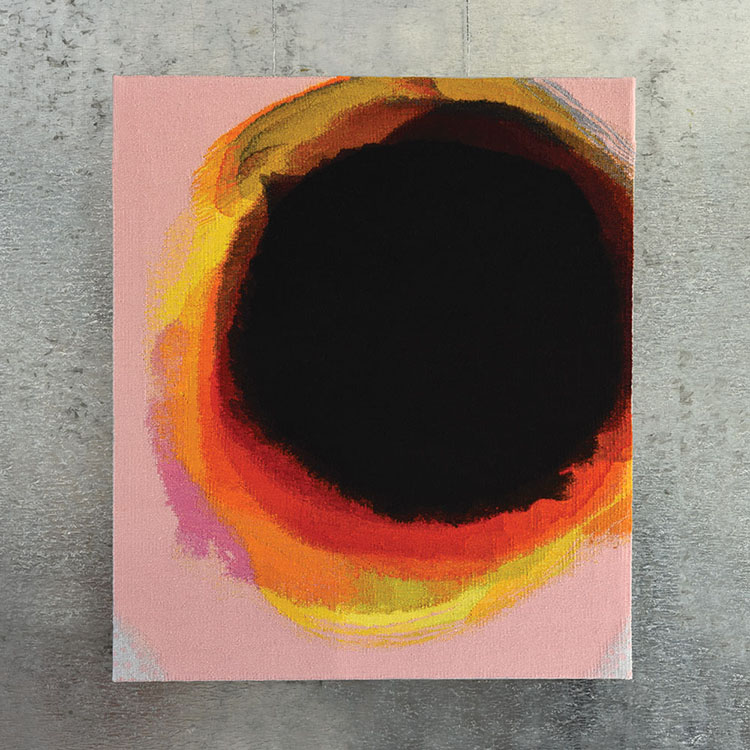
Dark Shimmer, Jo Barker , wool, cotton and embroidery threads, 34” x 29.25” x 1.25”, 2017, Photos by Tom Grotta
Dark Shimmer, by Scottish artist Jo Barker, is from the series for which she won the prestigious Cordis tapestry prize in 2016.

Complex Plaiting Series Pile 02, Norie Hatekayama , plaited paper fiber strips, 11” x 11” x 10”, 2002, Photo by Tom Grotta
Norie Hatakeyama’s Complex Plaiting Series, Pile 02 is made of paper tape. Hatakeyama’s plaited works reflect the complex structures that make up the universe. “Human beings explore structure in nature and create science and art,” she says. “I’ve observed that the transition of science (mathematics, geometry, etc.) and art overlaps with the direction of my work. I feel deeply that the outside world, the natural world, is a field, made up of matter and energy, repeating regeneration and radiating unremitting energy.”
Plunge: explorations above and below Opening Tonight, New Bedford Art Museum, Massachusetts
Rippling, roiling, teeming with life… Deep, dark, waiting to be explored…
Water has long been a potent influence for artists wishing to explore its majesty and mystery.
For the last several months, browngrotta arts has worked with Jamie Uretsky, Curator and Noelle Foye, Executive Director of the New Bedford Museum of Art/ArtWorks! in Massachusetts. Plunge: explorations from above and below, which examines the influence of water in the work of 16 artists from around the world, is the result.
The multifaceted exhibition combines sculptures, tapestries, installation works, paintings and photography. Each work resides at the intersection of the maker’s fascination with a variety of nautical and natural themes and the artmaking process. Plunge pairs Helena Hernmarck’s monumental woven depiction of tall ships in New York Bay 1884 and Chris Drury’s Double Echo, a print that superimposes a fragment of an echogram from Flight W34 over East Antarctica and an echocardiogram of the pilot’s heartbeat. In other galleries, Heather Hobler’s meditative photographs of seascapes join Karyl Sisson’s “sea creatures” made of domestic objects like zippers and clothespins; Christopher Volpe’s evocative paintings join Grethe Wittrock’s Arctica, a sculpture made from a repurposed sail from the Danish Navy. Unlike most musuem exhibtions, the works in Plunge are all available for sale.
Thirteen of the artists in Plunge, representing five countries, are represented by browngrotta arts: Dona Anderson; Jane Balsgaard; Annette Bellamy; Marian Bijlenga; Birgit Birkjaaer; Chris Drury; Helena Hernmarck; Lawrence LaBianca; Sue Lawty; Judy Mulford; Karyl Sisson; Ulla-Maija Vikman; Grethe Wittrock. Their work, and that of the three other artists in the exhibition, Heather Hobler, Anne Leone and Christopher Volpe, will be included in the catalog for the exhibition, designed and photographed by Tom Grotta. It will be available beginning June 5th at www.browngrotta.com.
Plunge’s opening is tonight Friday, June 2nd at the New Bedford Museum of Art from 6 p.m. to 8 p.m. Jane Balsgaard, one of the artists in Plunge, will attend from Denmark.
The New Bedford Art Museum is great cultural destination for those on the way to the Vineyard, Nantucket or the Cape. You have plenty of time to see it, as the exhibition continues through October 7, 2017. The New Bedford Art Museum/ArtWorks! is located at: 608 Pleasant Street/ New Bedford, MA/02740/508.961.3072/info@newbedfordart.org.
Art Assembled: Featured in April
April has been a busy month for us at bwongrotta arts. We’ve been celebrating our 30th Anniversary for the past 10 days so one of our new this week items was a short video about our 30th Anniversary exhibition, Still Crazy After All These Years…30 years in art.
We added outdoor sculpture for this exhibition and highlighted Dawn MacNutt’s bronze work, Timeless Figure, which began as a willow sculpture before it was cast in bronze.

34b Small Reliefs, Jane Balsgaard, willow, cotton rope, fishing line, handmade plant paper, plastic wire ties, 36” x 80”, 2015-16. Photo by Tom Grotta
Jane Balsgaard’s small reliefs of willow, cotton rope, fishing line, handmade plant paper and plastic wire ties also featured this month. Balsgaard’s airy “boats” of plant paper will be featured in Plunge: Explorations Above and Below at the New Bedford Art Museum, Massachusetts, that opens Memorial Day weekend, official opening June 2nd: http://newbedfordart.org. We’ve partnered with NBAM to mount Plunge; 13 of browngrotta arts’ artists will be included. We’ll be preparing a catalog for the exhibition which is open through October 8, 2017. This month we also drew attention to
Marian Bijlenga’s untitled work of horsehair, cotton and viscose. Bijlenga is one of the artists in Still Crazy as is Gyöngy Laky. Her is her work, Lefty Loosey, Righty Tighty a digital print combined with bullets for building.
Art Televised: Mary Merkel-Hess on PBS’s Craft in America
This month, the PBS series, Craft in America, will premiere its episode titled “Nature,” which features profiles on internationally acclaimed artists who use dimensional art to explore nature’s marvels. Among these visionaries is fiber artist Mary Merkel-Hess, a participant in browngrotta arts’ upcoming exhibition, Still Crazy After All These Years…30 years in art, slated to run from April 22nd through April 30th at the browngrotta arts’ barn/gallery in Wilton, Connecticut.
A native of the Midwest, Mary Merkel-Hess’ home state of Iowa represents the creative force behind many of the art pieces she fashions. By drawing inspiration from the area’s prairie elements, including its vast fields of grass, corn, shrubs and herbs, she creates dimensional art pieces that translate her experiences and familiarity with the Midwest and its unique aesthetics. In fact, many of her abstract pieces are inspired by the images she captures and masterfully replicates from the prairie garden surrounding her home and workshop.
Working with fiber and other materials, such as paper, wood, reed, and acrylic paint, Merkel-Hess creates what she refers to as “Landscape Reports,” fiber vessels that provide a sense of place and containment for the viewer to experience and enjoy. Her process involves building upon layers of paper with careful insertion of reed or cord, creating a mold that is then shaped and painted. Her fiber sculptures illustrate Iowa’s abundance of tall grass, fields and open green space, allowing others to bring a piece of the Midwest, as well as Merkel-Hess’ inspirational prairie garden, to their home.
Airing Friday, April 21, 2017, “Nature” will highlight Mary Merkel-Hess’ creative process, as well as that of other artists, sculptors and woodcarvers whose dimensional artwork challenges audiences to reassess their relationship to the natural world. Check you local PBS listings. You can view more samples of Merkel-Hess’ fiber artwork at http://www.browngrotta.com/Pages/hess.php.
Art Inside and Out: Sculpture featured at browngrotta arts’ 30th Anniversary
For our 30th anniversary exhibition, Still Crazy After All These Years…30 years in art, browngrotta arts will feature outdoor sculptures by two prominent international artists, Dawn MacNutt and Mariyo Yagi.
Dawn MacNutt, a native of the Canadian province Nova Scotia, incorporates an assortment of natural materials, such as twined willow, seagrass and copperwire, into each life-size sculpture. By crafting these column-like figures, MacNutt masterfully captures the beauty and frailty of the human form.
Among MacNutt’s masterpieces is, 2000–2005, a series of figures of willow and seagrass, each standing at 5’8” inches high. As with many of her fiber sculptures, MacNutt’s Return to Delos illustrates the humancondition as a source of imperfections and vulnerabilities but also reveals that, through these flaws, humans connect with one another and thereby create a sense of identity. She achieves this sentiment by leaving her columns purposely unfinished so that bare sticks remain untied and left to reach out to the world surrounding them. browngrotta arts’ exhibition features one of MacNutt’s willow figures cast in bronze, a material used by early imperial cultures. The bronze version is nearly indistinguishable from its willow counterpart, but the bronze permits the installation to withstand outdoor weather conditions.
Mariyo Yagi of Kobe, Japan, uses a combination of rope, bamboo, metal, and even glass to fashion a series of spiraling art installationsthat embody her theory of nawalogy—onenessmade of diversity. Through her art installations, she examines how nawa, the modern Japanese word for “rope,” is not made using one strand but, rather, with a series of strands inthe form of a spiral. Similar to how communication and inter-exchange establisha community, her pieces demonstrate how the energy from spiral structuresimitates the links between heaven and earth, as well as DNA and the universe.
There are also many indoor sculptural works featured in Still Crazy After All These Years, including John McQueen’s stitched twig figure, Askew, and Naoko Serino’s ethereal floating square of jute. Learn more about these and other artists in the browngrotta arts’ 30th anniversary exhibition on our Artists page.
browngrotta arts gets good press: Venü Magazine’s Spring Issue
 The cover story of the Spring Issue, No. 34 of Venü, the magazine of Contemporary Culture features browngrotta arts and our upcoming exhibition, Still Crazy After All These Years…30 years in art.
The cover story of the Spring Issue, No. 34 of Venü, the magazine of Contemporary Culture features browngrotta arts and our upcoming exhibition, Still Crazy After All These Years…30 years in art.
Author Cindy Clarke writes in Living Art, Timelessly Reimagined, that “Rhonda and Tom have a practiced eye for discovering museum-quality textural art and its accomplished creators. Over the last 30 years they have turned their finds into a premier art enterprise that’s in a class by itself…. Custom designed by the owners, the gallery itself is a dialog of opposites, blending elements of a historic two-story horse barn – think exposed beams, meticulously restored barndoors, original wide-plank wood flooring, vaulted ceilings – with grand, modernist spaces….
That’s the goal of this living gallery, of course, to show guests how different kinds of dimensional art fits into an environment and to give them permission and the encouragement to think out of the box to accommodate its human occupants.” Visit Still Crazy After All These Years at browngrotta arts. We will only be open for 10 days — April 22nd through April 30th; browngrotta arts, 276 Ridgefield Road, Wilton, CT 06897; http://www.browngrotta.com/Pages/calendar.php.
Search
Subscribe2
Recent Posts
- December 10, 2025
- December 3, 2025
- November 26, 2025
Pages
blogroll
Archives
- December 2025
- November 2025
- October 2025
- September 2025
- August 2025
- July 2025
- June 2025
- May 2025
- April 2025
- March 2025
- February 2025
- January 2025
- December 2024
- November 2024
- October 2024
- September 2024
- August 2024
- July 2024
- June 2024
- May 2024
- April 2024
- March 2024
- February 2024
- January 2024
- December 2023
- November 2023
- October 2023
- September 2023
- August 2023
- July 2023
- June 2023
- May 2023
- April 2023
- March 2023
- February 2023
- January 2023
- December 2022
- November 2022
- October 2022
- September 2022
- August 2022
- July 2022
- June 2022
- May 2022
- April 2022
- March 2022
- February 2022
- January 2022
- December 2021
- November 2021
- October 2021
- September 2021
- August 2021
- July 2021
- June 2021
- May 2021
- April 2021
- March 2021
- February 2021
- January 2021
- December 2020
- November 2020
- October 2020
- September 2020
- August 2020
- July 2020
- June 2020
- May 2020
- April 2020
- March 2020
- February 2020
- January 2020
- December 2019
- November 2019
- October 2019
- September 2019
- August 2019
- July 2019
- June 2019
- May 2019
- April 2019
- March 2019
- February 2019
- January 2019
- December 2018
- November 2018
- October 2018
- September 2018
- August 2018
- July 2018
- June 2018
- May 2018
- April 2018
- March 2018
- February 2018
- January 2018
- December 2017
- November 2017
- October 2017
- September 2017
- August 2017
- July 2017
- June 2017
- May 2017
- April 2017
- March 2017
- February 2017
- January 2017
- December 2016
- November 2016
- October 2016
- September 2016
- August 2016
- June 2016
- April 2016
- March 2016
- February 2016
- December 2015
- October 2015
- September 2015
- August 2015
- June 2015
- May 2015
- April 2015
- March 2015
- February 2015
- January 2015
- December 2014
- November 2014
- October 2014
- September 2014
- August 2014
- July 2014
- June 2014
- May 2014
- April 2014
- March 2014
- February 2014
- January 2014
- December 2013
- October 2013
- September 2013
- July 2013
- June 2013
- May 2013
- April 2013
- March 2013
- January 2013
- December 2012
- November 2012
- October 2012
- September 2012
- August 2012
- July 2012
- June 2012
- May 2012
- April 2012
- March 2012
- February 2012
- January 2012
- December 2011
- November 2011
- October 2011
- September 2011
- August 2011
- July 2011
- June 2011
- May 2011
- April 2011
- March 2011
- February 2011
- January 2011
- December 2010
- November 2010
- October 2010
- September 2010
- August 2010
- July 2010
- June 2010
- May 2010
- April 2010
- March 2010
- February 2010
- January 2010
- December 2009
- November 2009
- October 2009
- September 2009
- August 2009
Categories
- Acquisitions
- Aldrich Museum of Contemporary Art
- Allies for Art
- An Unexpected Approach
- Anniversary
- Architecture
- Art
- art + identity
- Art Assembled
- Art Materials
- art money
- Art Preview
- Art Textiles
- artist
- Artsy
- Awards
- bamboo
- Basketmakers
- Basketry
- Behind the Scenes
- Blue/Green
- Book Recommendations
- Books
- Catalogs
- Ceramics
- Charity
- Classes
- Collage
- Collectors
- Commentary
- Commission
- Commissions
- Danish Tapestry
- DIY
- Eco-Art
- Exhibitions
- Fashion
- Fiber Future
- Fiber Sculpture
- Film
- Galleries
- Gifts
- Guest Post
- History
- In the News
- Installations
- Japandi
- Japanese Art
- Japanese Ceramics
- Lectures
- Mixed Media
- Museums
- New This Week
- New York
- Obituary
- Obiturary
- Outdoors
- Paper
- Philadephia Museum of Art
- Photography
- Politics
- Pop-Up Exhibition
- Press
- Process Notes
- Sculpture
- SOFA
- Sweepstakes
- Tapestry
- tate modern
- Technology
- Text Art
- Travel
- Uncategorized
- Volume 50: Chronicling Fiber Art for Three Decades
- White
- White Art
- Who Said What
- Wood
- Workshops
Tags
Adela Akers art assembled Basketry browngrotta arts Carolina Yrarrázaval Dorothy Gill Barnes Ed Rossbach Gyöngy Laky Heidrun Schimmel Helena Hernmarck Hisako Sekijima James Bassler Jane Balsgaard Jennifer Falck Linssen Jin-Sook So Jiro Yonezawa John McQueen Judy Mulford Karyl Sisson Kay Sekimachi Kiyomi Iwata Kyoko KumaI Lawrence LaBianca Lenore Tawney Lewis Knauss Lia Cook Magdalena Abakanowicz Marian Bijlenga Mariette Rousseau-Vermette Mary Giles Mary Merkel-Hess Nancy Koenigsberg Nancy Moore Bess Naoko Serino Naomi Kobayashi Norma Minkowitz Rachel Max Randy Walker Sheila Hicks Sheila hicks Stéphanie Jacques Sue Lawty Tapestry Wendy Wahl Yasuhisa KohyamaAbout browngrotta.com
blogroll
reboot
site-ings
who's showing where
Subscribe
Pages
Archives
Calendar

